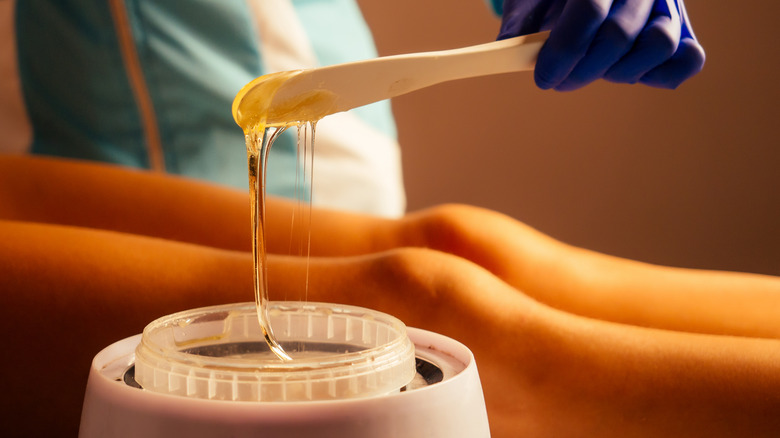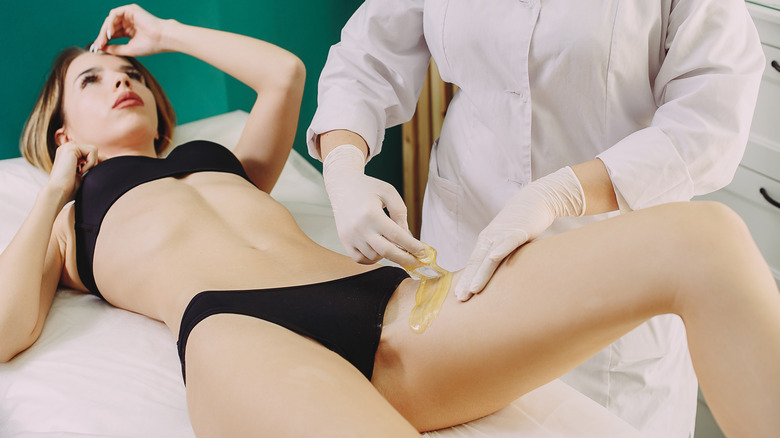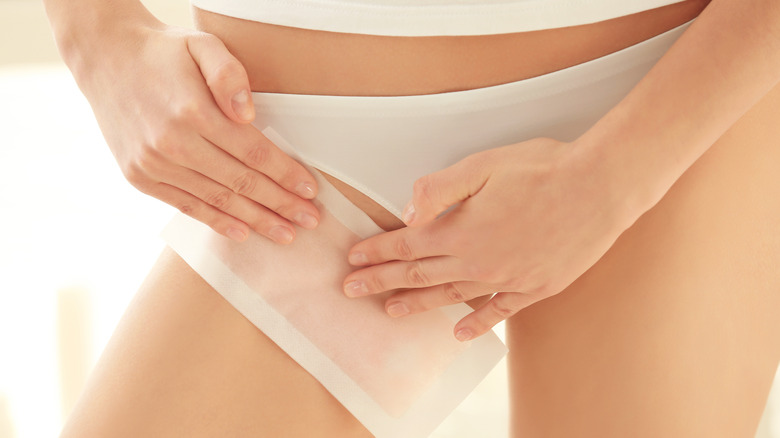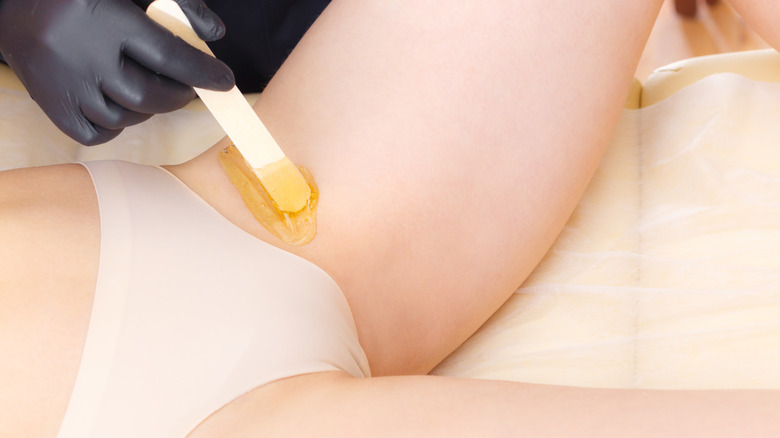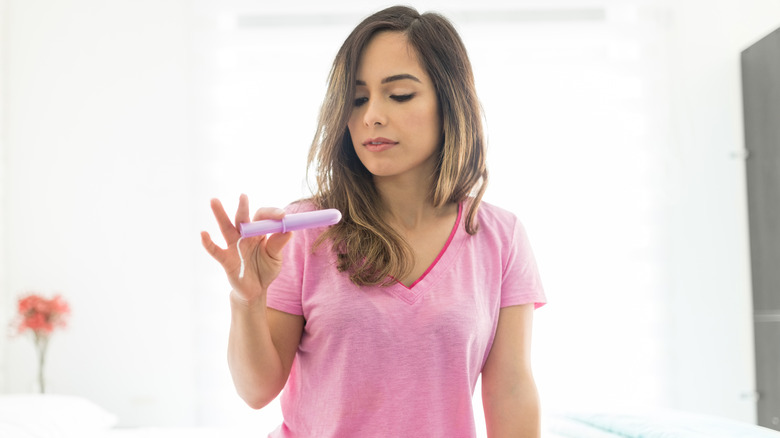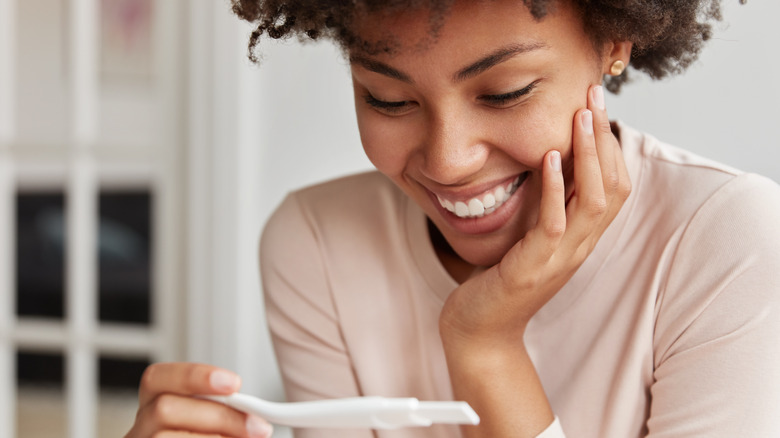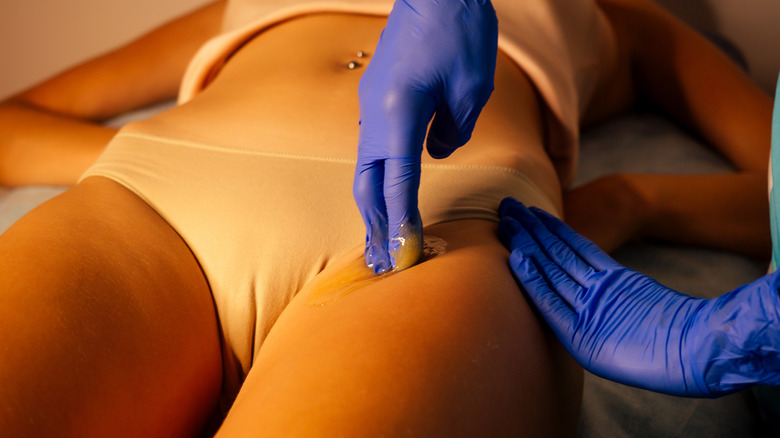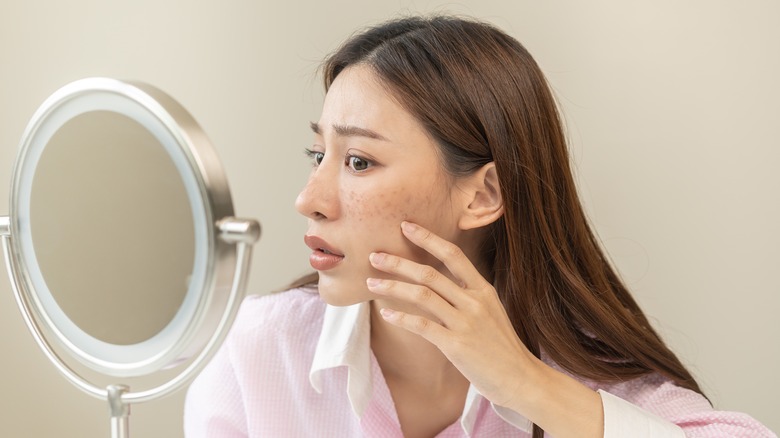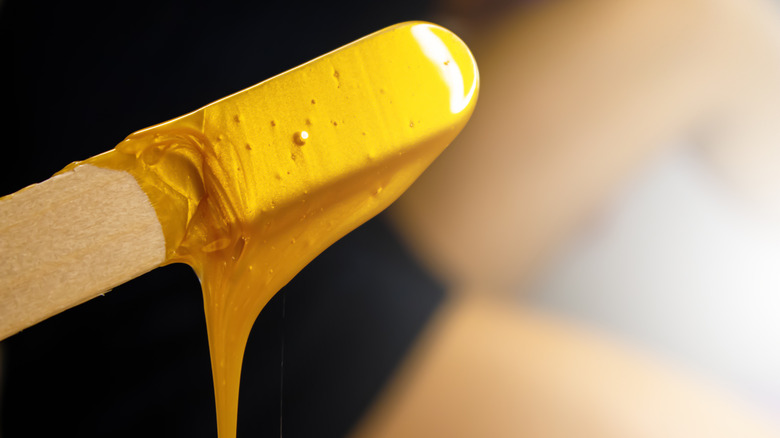Brazilian Wax: Everything You Should Know Before Your First Appointment
The heart wants what it wants — and sometimes, the heart leads you to book an appointment for a Brazilian wax. A part of you is thrilled. Another part of you is absolutely terrified or, at the very least, a little bit apprehensive about what's to come.
Rest assured, these reactions are completely normal. There's not a woman in existence who hasn't felt at least a pang of nervousness before heading off to her very first Brazilian wax. The good news, in addition to the fact that you're in good company, is that there are steps that you can take to make the experience far more manageable.
In fact, you might even find that you enjoy it more than you anticipate. What's the secret to a successful appointment? From when it's safe to get a Brazilian wax to preparing for your first visit, here's everything you need to know to ensure that it goes smoothly.
What is a Brazilian wax?
A Brazilian wax is a grooming service that involves the removal of all of the hair in the genital region. This includes the labia, the pubic bone, the anus, and the upper thighs. Given that it covers your entire undercarriage, it's the best choice for those who prefer smooth skin and don't want to worry about upkeep at home. Practitioners offer the option of leaving a small landing strip or triangle on top. Some people just prefer the way that this looks.
The service was first introduced to America in the early '90s at the J Sisters salon in New York City, owned by Brazilian Janea Padilha and her six sisters. She was inspired to offer Brazilian waxing in America because she had already spent years performing it on others in her native Brazil.
The service took off, the dot-com boom followed not long thereafter, and the word spread like wildfire. Before long, everyone was booking appointments at the salon for the newfangled approach to hair removal — and it eventually grew so popular that other salons around the country started to offer it, too.
How does a bikini wax differ?
The two terms are sometimes used interchangeably, but Brazilian and bikini waxes are dramatically different from one another. While the former leaves your nether regions completely bare, a bikini wax consists of removing hair strictly along the bikini line. Yep, bid farewell to those little bits of hair that sometimes peek out when you pull on your swimsuit or your underwear.
All the other hair normally pulled away from your skin during a Brazilian wax — looking at you, vulva and pubic bone — stays put. While there's really just one type of Brazilian wax, there are a couple of different ways to perform bikini hair removal.
One is to simply tackle the hair along the bikini line. A variation known as the "bikini full" is something of a compromise, offering the best of both worlds. Your practitioner will remove the hair along your bikini line along with the hair on your labia and pubic bone but won't touch the hair near your anus. Since there's more hair removal involved, you'll pay extra for this service.
How long should your hair be for waxing?
Yes, your hair needs to be a specific length before you wax. The wax needs something to grip onto in order to pull it from the root and leave your skin as smooth and free of stubble as possible — and if there isn't enough hair, then the wax won't hold onto it properly. This can lead individual hairs to snap and cause a patchy finish.
In a worst-case scenario, though, the wax may not pull the hair out at all if there isn't enough there. This won't just disappoint you but also leave your skin irritated! Jodi Shays, the owner of Queen Bee Salon & Spa, tells Good Housekeeping that the hair "should be at least a quarter of an inch long for your waxing session."
Yes, that means waiting just a little longer than you may like to book your appointment, but the end result will be worth it. You can help your situation by leaving your hair alone — don't trim it or use a razor, or you'll just need to wait even longer for a successful Brazilian wax.
What should you do to prepare?
There are several steps you can take to ease your discomfort (and your nerves) before your appointment. Either the evening before waxing day or the day of the visit, exfoliate your skin. Leyda Quintero, a lead aesthetician at Bliss Spa Soho, explains to Well + Good, "If your skin isn't doing a great job of shedding on its own, it can trap hairs underneath so that you won't get as effective of a wax."
To prep your skin before your waxing appointment, use a gentle exfoliating agent that won't irritate your skin. Opt for sugar-based formulas over salt, as the latter may cause discomfort that only exacerbates any pain you might feel during the actual waxing service. However, avoid using an exfoliator on the nether region for a few days after your appointment, or irritation could ensue.
Another important step is to take an anti-inflammatory about half an hour to an hour before your appointment. That can ease some of the discomfort and make it far more tolerable. Wear loose, lightweight attire, including breathable underwear. You don't want to risk disturbing your skin even more in the aftermath of wax.
Is there any hygiene etiquette to follow?
Just like gynecologists, professionals who perform Brazilian waxes for a living have seen it all. Nothing surprises or fazes them — so you can eliminate that worry from your list once and for all. That said, you may feel a little more confident and comfortable if you follow a few basic etiquette tips before your appointment. The first is to clean up properly beforehand. Take a shower or bath and clean your genitals thoroughly.
Do not worry about natural bodily fluids. "Natural" is the keyword, and remember that your aesthetician has seen it all. Plus, you can always pop into the restroom to answer nature's call if necessary and clean up one more time before your appointment starts. Keep in mind that it's normal for humans to sweat. If you're a little damp down there, don't "sweat" it.
Finally, tempting as it might be to have a glass of wine before the appointment to calm yourself, you don't want to do this. Nandi Wagner, a lead aesthetician at Bliss Soho, tells The Zoe Report, "Alcohol is a vasodilator — it thins your blood, making it easier for you to bleed during hair removal." Save the liquid courage for after the appointment as a pat on the back for, well, your courage.
Can you get a Brazilian wax during your period?
Life doesn't stop just because you have your period — and that includes Brazilian waxes, which may actually help some people feel a little fresher during that time of the month. Most salons encourage their clients to come in for their appointment regardless, but there's a caveat.
Deidra Green, a licensed and certified aesthetician, says to Shape, "We always want to ensure that we are being as safe and sanitary as possible in the wax suite. So although our cleaners are strong enough to kill bloodborne pathogens, it is safer to use a tampon or menstrual cup to reduce any exposure."
However, know your limits. Not everyone feels comfortable undergoing such an intimate experience during their period. And, in fact, there's a big reason for that: Because hormonal levels fluctuate so dramatically during this time, you're more prone to suffering from increased sensitivity. Dr. Jessica Shepherd tells Women's Health that those hormones "really do increase the sensitivity of the skin. Waxing during that time could elicit more tenderness in that area."
Is it safe to get a Brazilian wax during pregnancy?
The very fact that you're thinking about getting your very first Brazilian wax during pregnancy solidifies you as a queen amongst queens. However, you're also a very human queen who might be slightly anxious about the experience. Just like during your menstrual period, your hormones are all over the place when you're pregnant. That means that, yes, your skin is likely to be more sensitive during this time.
That's the only caveat, though. If you'd like to schedule a Brazilian wax while you're expecting, you can! Of course, it's better to do so earlier in the pregnancy when you can still maneuver around without much effort. If you aren't certain, ask your doctor for their opinion.
And if you want to go ahead but feel a little hesitant when you arrive, ask your aesthetician to perform a patch test. You'll get a feel for the experience and can decide at that point if you can tolerate it. If you'd rather go for a less intense experience, consider trimming or shaving the hair instead.
Are there any side effects?
You shouldn't be surprised if you experience some side effects after your first Brazilian wax — or even after your fifth. It's super common for the skin to become bright red. After all, the hair has been pulled from the root. Often, practitioners will apply a soothing wipe or cream to settle the area before you leave. Some people also develop bumps similar to razor bumps, but this rash usually subsides on its own.
Another common side effect is hotter skin. Keri Raciti from Harley Wax explains to Cosmopolitan, "It is recommended that a bikini wax is performed with the use of a professional hot or film wax, which is specifically formulated to effectively grip the hair in this area." This naturally heats the area, and you might even find that you perspire a little bit. It's normal and should resolve quickly. Per Cleveland Clinic, a very small percentage of people may develop a condition called vulvodynia, which alludes to "chronic pain of the vulva."
When should you avoid a Brazilian wax?
A study published in Clinical Infectious Diseases found that people who are "immunocompromised," such as those with diabetes and transplant recipients, are not candidates for Brazilian waxing because they "may be at high risk of infectious complications." Since "infectious risks" can occur for anybody when getting a wax, those who are immunocompromised may have an even more difficult time fighting them off.
Per Best Health Magazine, individuals who suffer from skin conditions such as psoriasis or eczema may also wish to forgo waxing because their skin is more prone to irritation. Even if you normally would be a candidate, you should avoid it completely if your skin in the area is sunburned.
Dermatologist Shilpi Khetarpal tells the Cleveland Clinic that those who have taken isotretinoin to treat acne within six months of the appointment should also put it off. "Waxing while taking isotretinoin can cause permanent scars. And that goes for both hot and cold wax," she says.
What is the difference between hard and soft wax?
Some salons offer just one type of wax, while others have both hard and soft on the menu. Hard wax is extremely thick. It's "stripless" in that it doesn't require muslin cloths to lift it off the skin. It's simply pressed onto the skin, where it hardens on contact. Despite this, it's still flexible enough to lift away in a single, swift maneuver.
By contrast, soft wax is a very pliable material. Unlike hard wax, which adheres to the skin and the hair, soft wax sticks strictly to the hair. In order to remove it, the aesthetician must use a muslin strip to pull the wax away along with the hair.
Usually, hard wax is the go-to choice for Brazilian waxing. It can be reapplied to the treatment area and provides a little more "pull," making it an effective choice for people with more coarse hair. Because soft wax can't be reapplied, you run the risk of additional discomfort if your aesthetician is inexperienced and neglects to pull up all of the hair in a single motion. Soft wax is a better option for the bikini line.
Do Brazilian waxes hurt?
It's important to be prepared, but not to scare yourself silly. Aesthetician Keiann Roberts tells Health, "The anticipation is the worst part. Usually as soon as the wax is done, [clients] say it isn't as bad as they thought it would be."
So, yes, there may be some pain. That's almost a given, considering your hair is about to be pulled from its roots. Some people experience minimal discomfort, while others feel far more intense pain. You know your personal pain threshold best, and you should always, always, always do what you feel is most comfortable.
With the understanding that this may be uncomfortable, you can ease some of your anxieties simply by being as prepared as you can be. You can minimize bikini wax pain by taking your painkillers before the appointment, avoiding going in during your period if you're worried about added sensitivity, and asking your practitioner about soothing treatments they have on hand to ease any post-wax discomfort that you might feel.
How often should you schedule waxing?
Given that it's your first time, you might not be certain if you want to commit to a regular Brazilian waxing routine just yet. Once you get a feel for the results, you might be especially compelled to make it a habit. Keep in mind that results should last about two weeks before hair begins to regrow.
However, Leia Hohenfeld, a licensed esthetician, tells Healthline, "If it's your first time, I recommend scheduling the first two or three appointments every four weeks and transitioning to every five to six weeks for maintenance." Then, you can gradually adjust that timeframe to a six-week period to maintain the results.
Why the increase? It turns out that the more you wax, the less your hair grows back. Per the Cortiva Institute, waxing transmits a new message to your brain over time. Essentially, it conveys a signal to the hair that it no longer needs to grow back as quickly since it's continuously pulled from its roots. Plus, the very act of tugging hair in this manner "weakens the hair shaft. That will result in reduced hair growth."
How can you tell your salon is safe?
No matter what treatment you book, you should be confident that your salon is sanitary. Per the Barber Cosmo Board of Barbering & Cosmetology in Sacramento, each aesthetician's license should be displayed at the establishment. This may differ by state, so check out your local laws prior to the appointment. When you're ready for your appointment, observe their practices closely. The practitioner should wash their hands and wear a pair of fresh gloves before getting started.
If you'd like further assurance, ask them about their disinfection rules. Everything should be sanitized, but if it's disposable, it should be thrown out immediately. A few red flags to watch out for include reused wax strips and double dipping. The latter is an especially serious issue, occurring when the practitioner dips a stick in hot wax more than once instead of using a new one. That leads to contamination which can affect everyone else who comes in for service.
Is it safe to have sex after a wax?
It is safe to have sex after waxing, but it's dependent on a few factors. When you're new to the world of Brazilian waxing, you should ideally give yourself some time to recover. Friction, rubbing, and touching can cause further irritation, affecting your skin's ability to heal property in the aftermath of the service.
As a newcomer to Brazilian waxing, it's usually best to give it at least a day for your redness to diminish and any lingering discomfort to pass. This situation may change considerably as you grow more accustomed to it. Esthetician Jodi Shays tells Allure, "If you've been waxing for a long time — and I mean Brazilians, labia and all, on a regular basis — then go for it. You can probably handle having sex that night."
If your goal is to achieve smoother skin before something special, like a romantic night with your partner, schedule your first Brazilian wax a few days in advance to be safe. During that time, if it's necessary, you can use ice packs and aloe vera gel to soothe your skin and help it recover.
What is the aftercare for a Brazilian wax?
You can take a couple of other steps to prevent post-wax pain. Don't exercise after your appointment, as the open pores could invite bacterial intrusion and lead to an infection. Melanie Coba, a waxing professional at European Wax Center, tells Marie Claire, "Avoid touching your newly hair-free skin. This will only clog pores and transfer the bacteria that's on your hands onto your newly waxed skin."
Avoid any other heat sources, too, as your skin will be especially sensitive during this time. Beyond sweating, skip the soak in the hot tub, as the excessive warmth may irritate your skin. Finally, do your utmost to avoid ingrown hairs by gently cleaning the area with a soft exfoliator and finishing with a light moisturizer. Don't use a razor, as this could encourage an ingrown issue; instead, schedule your next Brazilian wax and set yourself on the path to consistently smoother skin.
